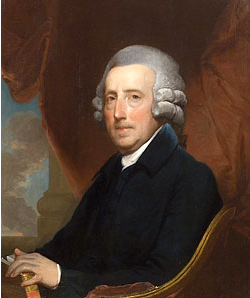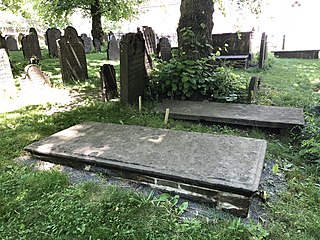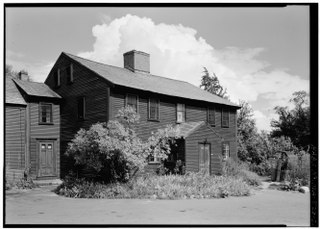
Sir William Beckford was a British Whig politician who twice served as Lord Mayor of London in 1762 and 1769. One of the best known political figures in Georgian era London, his vast wealth derived from the sugar plantations and hundreds of slaves he owned in the British colony of Jamaica. In Britain, Beckford was a supporter of the Whig party, including Prime Minister William Pitt, 1st Earl of Chatham. He also publicly supported progressive causes and frequently championed the London public.

The Province of North Carolina, originally known as Albemarle Province, was a proprietary colony and later royal colony of Great Britain that existed in North America from 1712 to 1776.(p. 80) It was one of the five Southern colonies and one of the thirteen American colonies. The monarch of Great Britain was represented by the Governor of North Carolina, until the colonies declared independence on July 4, 1776.

Manasseh Cutler was an American Congregational clergyman involved in the American Revolutionary War. He was influential in the passage of the Northwest Ordinance of 1787 and wrote the section prohibiting slavery in the Northwest Territory. Cutler was also a member of the United States House of Representatives. Cutler is "rightly entitled to be called 'The Father of Ohio University.'"

The Boston Gazette (1719–1798) was a newspaper published in Boston, in the British North American colonies. It was a weekly newspaper established by William Brooker, who was just appointed Postmaster of Boston, with its first issue released on December 21, 1719. The Boston Gazette is widely considered the most influential newspaper in early American history, especially in the years leading up to and into the American Revolution. In 1741 the Boston Gazette incorporated the New-England Weekly Journal, founded by Samuel Kneeland, and became the Boston-Gazette, or New-England Weekly Journal. Contributors included: Samuel Adams, Paul Revere, Phyllis Wheatley.

The Most Worshipful Grand Lodge of Ancient Free and Accepted Masons of the Commonwealth of Massachusetts, commonly referred to as the Grand Lodge of Massachusetts and abbreviated GLMA, is the main governing body of Freemasonry within Massachusetts, and maintains Lodges in other jurisdictions overseas, namely Panama, Chile, the People's Republic of China, and Guantanamo Bay Naval Base, Cuba.

Thomas Dawes was a patriot who served as a Massachusetts militia colonel during the American Revolution and afterward assumed prominent positions in Massachusetts's government. His positions included membership and chairmanship of the Massachusetts Governor's Council and representative in both the House and Senate. As chairman of the Governor's Council, Dawes served briefly as the de jure presiding officer of the executive branch of Massachusetts' state government for ten days – May 20, 1800 to May 30, 1800 – following the death of first Governor Increase Sumner and then Lieutenant Governor Moses Gill.

Colonel Isaac Royall Jr. was an Antiguan-born merchant, politician, slave trader and military officer who spent the majority of his life in the Province of Massachusetts Bay.
Johannes Roosevelt, known as John Roosevelt, was a New York City businessman and politician and the progenitor of the Oyster Bay Roosevelts, including Theodore and Eleanor Roosevelt.

The Quincy family was a prominent political family in Massachusetts from the mid-17th century through to the early 20th century. It is connected to the Adams political family through Abigail Adams.
Mungo Mackay was a Scottish seafarer from the Orkney Islands who made a fortune in the Boston shipping trades in Massachusetts. Mungo was a highly regarded ship master, successful privateer owner and bonder, and operated a store on Long Wharf in Boston. He was also active in the politics of the town of Boston and the Masonic Order in Boston. His legacy includes the Alpheus Babcock and Jonas Chickering piano manufacturing establishments.

New South Church (1714-1866) was a Congregational Unitarian church of the "New South Society" in Boston, Massachusetts, located on "Church Green" at the corner of Summer Street and Bedford Street. Pastors included Samuel Checkley and John Thornton Kirkland. In 1814 architect Charles Bulfinch designed a new building for the society; it was demolished in 1868. The congregation merged with the New South Free Church in 1866.
Joseph Badger was a portrait artist in Boston, Massachusetts, in the 18th century. He was born in Charlestown, Massachusetts, to tailor Stephen Badger and Mercy Kettell. He "began his career as a house-painter and glazier, and ... throughout his life continued this work, besides painting signs, hatchments and other heraldic devices, in order to eke out a livelihood when orders for portraits slackened." In 1731 he married Katharine Felch; they moved to Boston around 1733. He was a member of the Brattle Street Church. He died in Boston on May 11, 1765, when "on Saturday last one Mr. Badger, of this Town, Painter, was taken with an Apoplectic Fit as he was walking in his Garden, and expired in a few Minutes after." Works by Badger are in the collections of the Worcester Art Museum, the Museum of Fine Arts Boston, and Historic New England's Phillips House, Salem, Mass. While respected in his own time, subsequent scholars and connoisseurs largely overlooked Badger's significance until Lawrence Park wrote a book about him in 1918.

Merchants Row in Boston, Massachusetts, is a short street extending from State Street to Faneuil Hall Square in the Financial District. Since the 17th century, it has been a place of commercial activity. It sits close to Long Wharf and Dock Square, hubs of shipping and trade through the 19th century. Portions of the street were formerly known as Swing-Bridge Lane, Fish Lane, and Roebuck Passage.
James Gibson was a merchant in the British colonies of Jamaica and the Province of Massachusetts Bay. During King George's War (1744–1748), William Shirley, the Governor of Massachusetts, debated whether to siege and capture the French fortress of Louisburg on Cape Breton Island, Nova Scotia. According to Gibson's journal, he convinced Governor Shirley that the siege would be successful and used his personal wealth to provide 300 soldiers for the campaign. Gibson wrote an account of the Siege of Louisburg, and it was published in London in late 1745.

The First Church in Roxbury, also known as the First Church of Roxbury is the current headquarters of the Unitarian Universalist ("UU") Urban Ministry. A church on this site has been in use since 1632 when early English settlers built the first meetinghouse. Since then, the meetinghouse has been rebuilt four times, and its appearance today reflects how the meetinghouse looked in the late 19th and early 20th centuries.

Benjamin Kent (1708–1788) was a Massachusetts Attorney General (1776–1777) and then acting Attorney General during much of Robert Treat Paine's tenure (1777–1785). He was appointed seven successive terms. Prior to the American Revolution, Kent was notable for his representation of slaves suing their masters for their freedom, which contributed to the demise of slavery in Massachusetts. He was a member of the North End Caucus and prominent member of the Sons of Liberty, which formed to protest the passage of the Stamp Act of 1765. The efforts of the Sons of Liberty created the foundation for the Boston Tea Party. Kent called for independence early in the American Revolution.

Hartwell Tavern is a historic American Revolutionary War site associated with the revolution's first battle, the 1775 battles of Lexington and Concord. It is located on North County Road, just off Battle Road in Lincoln, Massachusetts, and is operated as a historic house museum by the National Park Service as part of the Minute Man National Historical Park. Built in 1733, in what was then Concord, it is staffed from Memorial Day weekend to October by park rangers dressed in colonial attire who offer programs daily.

The 1837 Massachusetts gubernatorial election was held on November 13.

The Samuel Hartwell House is a historic American Revolutionary War site associated with the revolution's first battle, the 1775 battles of Lexington and Concord. Built in 1733, in what was then Concord, it was located on North County Road, just off Battle Road in today's Lincoln, Massachusetts, and about 700 feet east of Hartwell Tavern, which Hartwell built for his son, Ephraim, and his newlywed wife, Elizabeth, in 1733. The site is part of today's Minute Man National Historic Park.

















